-
 Bitcoin
Bitcoin $105,953.9980
3.06% -
 Ethereum
Ethereum $2,445.3292
6.68% -
 Tether USDt
Tether USDt $1.0006
-0.03% -
 XRP
XRP $2.1968
7.03% -
 BNB
BNB $643.2903
2.13% -
 Solana
Solana $144.2799
3.82% -
 USDC
USDC $1.0000
-0.03% -
 TRON
TRON $0.2739
0.49% -
 Dogecoin
Dogecoin $0.1642
4.47% -
 Cardano
Cardano $0.5834
5.49% -
 Hyperliquid
Hyperliquid $38.0741
2.80% -
 Sui
Sui $2.7741
7.56% -
 Chainlink
Chainlink $13.4107
11.26% -
 Bitcoin Cash
Bitcoin Cash $450.4828
-0.61% -
 UNUS SED LEO
UNUS SED LEO $9.1301
0.64% -
 Stellar
Stellar $0.2476
5.49% -
 Avalanche
Avalanche $18.0637
5.09% -
 Toncoin
Toncoin $2.9066
2.43% -
 Shiba Inu
Shiba Inu $0.0...01160
4.01% -
 Hedera
Hedera $0.1527
8.00% -
 Litecoin
Litecoin $84.6122
2.37% -
 Monero
Monero $317.6076
5.76% -
 Ethena USDe
Ethena USDe $1.0008
0.02% -
 Polkadot
Polkadot $3.4519
5.27% -
 Dai
Dai $1.0000
-0.03% -
 Bitget Token
Bitget Token $4.2835
5.62% -
 Uniswap
Uniswap $7.0443
9.78% -
 Pepe
Pepe $0.0...09964
7.41% -
 Pi
Pi $0.5391
4.64% -
 Aave
Aave $264.1743
11.26%
How to use BOLL in combination with trading volume? Is it more reliable to break through the upper track with large volume?
Breaking through the upper Bollinger Band with large volume can be a reliable signal for a potential uptrend continuation in cryptocurrency trading.
May 22, 2025 at 01:29 pm
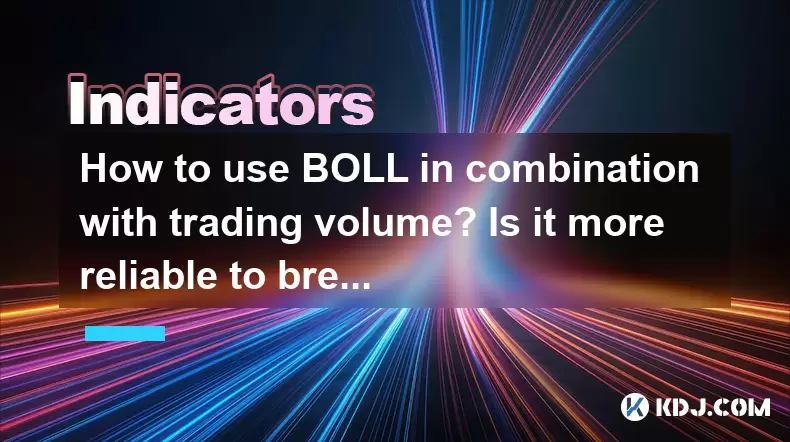
The Bollinger Bands (BOLL) indicator is a versatile tool used by many traders in the cryptocurrency market to assess volatility and potential price movements. When combined with trading volume, it can provide a more comprehensive view of market dynamics. This article will explore how to effectively use BOLL in conjunction with trading volume and discuss whether breaking through the upper track with large volume is a more reliable signal.
Understanding Bollinger Bands (BOLL)
Bollinger Bands consist of three lines: the middle band, which is typically a simple moving average (SMA); the upper band, which is the SMA plus a certain number of standard deviations; and the lower band, which is the SMA minus the same number of standard deviations. The standard setting for BOLL is a 20-day SMA with the upper and lower bands set at two standard deviations away from the SMA.
The primary function of BOLL is to identify periods of high and low volatility. When the bands are close together, it indicates low volatility, and when they are far apart, it suggests high volatility. Traders often look for price breakouts from the bands as potential signals for entry or exit points.
Incorporating Trading Volume with BOLL
Trading volume is the total number of shares or contracts traded within a specified time frame. It is a crucial indicator of the strength behind price movements. High volume often confirms the validity of a price move, while low volume might indicate a lack of conviction among traders.
When combining BOLL with trading volume, traders can gain insights into the strength of price breakouts. For instance, if a cryptocurrency price breaks above the upper Bollinger Band with high volume, it might indicate strong buying pressure and a potential continuation of the uptrend.
Steps to Use BOLL and Trading Volume in Analysis
To effectively use BOLL and trading volume in your trading strategy, follow these steps:
- Identify the Bollinger Bands on your chart: Ensure your trading platform has the BOLL indicator enabled. The default settings are typically a 20-day SMA with two standard deviations for the upper and lower bands.
- Observe price movements relative to the bands: Look for instances where the price touches or breaks through the upper or lower band. These are potential signals for increased volatility.
- Check the trading volume: When a price breakout occurs, check the corresponding volume. High volume during a breakout above the upper band or below the lower band can confirm the strength of the move.
- Analyze the context: Consider the overall market conditions and other technical indicators. A breakout with high volume might be more significant if it aligns with other bullish or bearish signals.
- Make trading decisions: Based on your analysis, decide whether to enter or exit a trade. For example, a breakout above the upper band with high volume might be a signal to buy, while a breakout below the lower band with high volume could be a signal to sell.
Is Breaking Through the Upper Track with Large Volume More Reliable?
Breaking through the upper track with large volume can indeed be considered a more reliable signal for a potential continuation of an uptrend. This is because high volume suggests strong buying interest and conviction among traders. When the price breaks above the upper Bollinger Band with significant volume, it often indicates that the upward momentum is strong enough to sustain further price increases.
However, it is essential to consider other factors as well. For instance, if the market is overbought or if there are other bearish indicators present, even a high-volume breakout might not be as reliable. Therefore, always use this signal in conjunction with other technical analysis tools to validate your trading decisions.
Examples of BOLL and Volume Analysis in Cryptocurrency Trading
Let's consider a few hypothetical examples to illustrate how BOLL and trading volume can be used in cryptocurrency trading:
- Example 1: Bitcoin (BTC) is trading in a tight range with the Bollinger Bands close together, indicating low volatility. Suddenly, the price breaks above the upper band with a significant increase in volume. This could be a signal for traders to enter a long position, expecting further upward movement.
- Example 2: Ethereum (ETH) has been trending downwards, and the price touches the lower Bollinger Band with low volume. This might suggest a lack of selling pressure and could be a sign of a potential reversal. If the price then breaks above the middle band with increasing volume, it could confirm a bullish reversal.
- Example 3: A lesser-known altcoin experiences a sudden spike in price, breaking above the upper Bollinger Band. However, the volume remains low. This could indicate a false breakout, and traders might be cautious about entering a position based on this signal alone.
Practical Tips for Using BOLL and Volume in Trading
To maximize the effectiveness of using BOLL and trading volume in your trading strategy, consider the following tips:
- Use multiple timeframes: Analyze the BOLL and volume on different timeframes to get a more comprehensive view of the market. A breakout on a daily chart with high volume might be more significant than one on a 15-minute chart.
- Combine with other indicators: Use BOLL and volume in conjunction with other technical indicators such as the Relative Strength Index (RSI) or Moving Average Convergence Divergence (MACD) to validate your signals.
- Set stop-loss orders: Always set stop-loss orders to manage risk, especially when trading based on breakouts. A breakout with high volume can still fail, and stop-loss orders can help limit potential losses.
- Monitor market news: Be aware of any significant news or events that could impact the cryptocurrency market. High volume breakouts might be driven by external factors, and understanding these can help you make more informed trading decisions.
FAQs
Q1: Can Bollinger Bands be used effectively in all market conditions?
A1: Bollinger Bands are versatile and can be used in various market conditions. However, they are most effective in trending markets where volatility is more pronounced. In sideways or ranging markets, the bands might not provide as clear signals, and traders might need to rely more on other indicators.
Q2: How often should I check the trading volume when using Bollinger Bands?
A2: It is beneficial to check the trading volume regularly, especially during significant price movements or when the price approaches or breaks through the Bollinger Bands. Real-time or near real-time volume data can help you make more timely and informed trading decisions.
Q3: Are there any specific cryptocurrencies where BOLL and volume analysis works better?
A3: BOLL and volume analysis can be applied to any cryptocurrency. However, they might be more effective with cryptocurrencies that have higher liquidity and trading volumes, such as Bitcoin and Ethereum. For less liquid altcoins, volume data might be less reliable, and other factors might need to be considered.
Q4: Can I use Bollinger Bands and volume analysis for short-term trading?
A4: Yes, Bollinger Bands and volume analysis can be used for short-term trading. Traders often use shorter timeframes, such as 5-minute or 15-minute charts, to identify quick entry and exit points based on breakouts and volume spikes. However, be aware that short-term trading carries higher risk and requires careful risk management.
Disclaimer:info@kdj.com
The information provided is not trading advice. kdj.com does not assume any responsibility for any investments made based on the information provided in this article. Cryptocurrencies are highly volatile and it is highly recommended that you invest with caution after thorough research!
If you believe that the content used on this website infringes your copyright, please contact us immediately (info@kdj.com) and we will delete it promptly.
- BlockDAG: The Cryptocurrency ROI Revolution
- 2025-06-25 06:45:12
- Layer 1 Crypto Token Presales: What's Hot in the NYC Crypto Scene?
- 2025-06-25 06:30:12
- Ethereum, Investors, and Memecoins: A Wild Ride on the Crypto Coaster
- 2025-06-25 06:30:12
- SEI Price Explodes: Is This Just the Beginning?
- 2025-06-25 07:05:13
- Meme Coins Mania: Arctic Pablo and the Hunt for Presale Gains
- 2025-06-25 06:50:13
- Mark Cuban, Meme Coins, and Scams: A Cautionary Tale
- 2025-06-25 07:05:13
Related knowledge
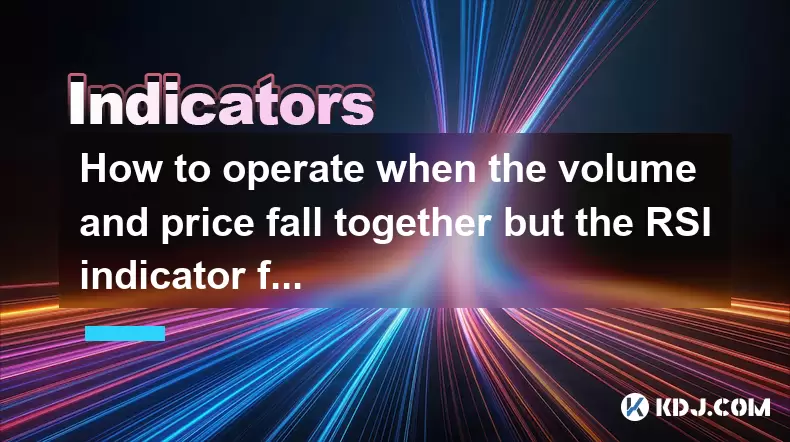
How to operate when the volume and price fall together but the RSI indicator forms a bottom divergence?
Jun 25,2025 at 04:29am
Understanding the Concept of RSI Bottom DivergenceWhen analyzing cryptocurrency price charts, traders often rely on technical indicators to spot potential reversals. One such signal is a bottom divergence in the Relative Strength Index (RSI). This occurs when the price makes a new low, but the RSI does not confirm that low and instead forms a higher low...
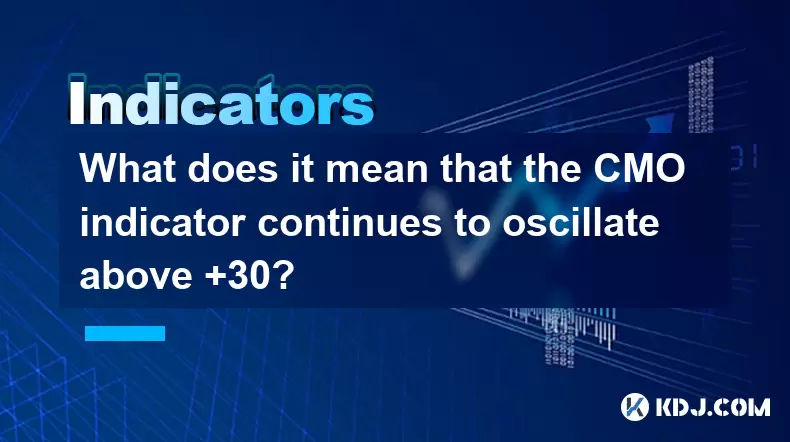
What does it mean that the CMO indicator continues to oscillate above +30?
Jun 25,2025 at 03:29am
Understanding the CMO IndicatorThe Chande Momentum Oscillator (CMO) is a technical analysis tool developed by Tushar Chande to measure momentum in financial markets. In cryptocurrency trading, the CMO helps traders identify overbought or oversold conditions and potential trend reversals. The oscillator ranges from -100 to +100, with values above zero in...

What does it mean that the ATR indicator suddenly doubles after hitting a new low this year?
Jun 24,2025 at 11:57pm
Understanding the ATR IndicatorThe Average True Range (ATR) is a technical analysis indicator used to measure market volatility. Developed by J. Welles Wilder, ATR calculates the average price range between a security’s high and low over a specific period—typically 14 periods. It does not indicate the direction of price movement but rather how volatile ...
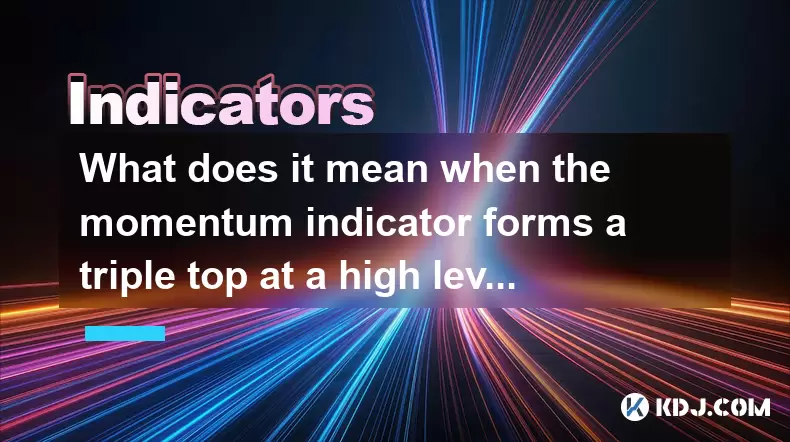
What does it mean when the momentum indicator forms a triple top at a high level?
Jun 25,2025 at 03:15am
Understanding the Momentum Indicator in Cryptocurrency TradingThe momentum indicator is a widely used technical analysis tool that measures the rate of change in price movements over a specified period. In cryptocurrency trading, where volatility is high and trends can reverse rapidly, this indicator helps traders identify potential trend reversals or c...
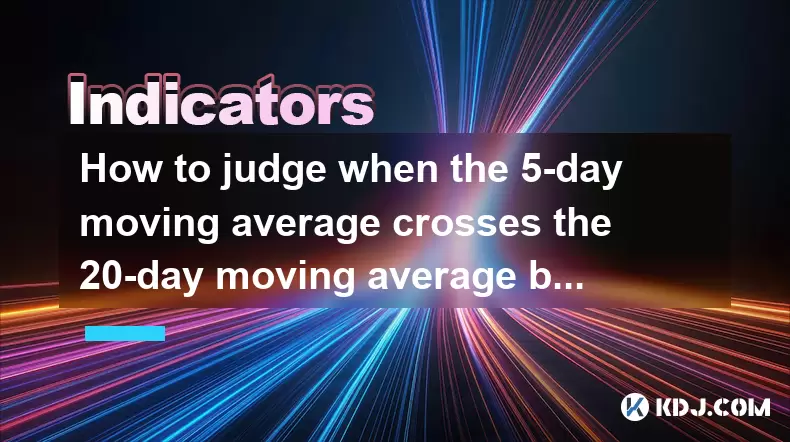
How to judge when the 5-day moving average crosses the 20-day moving average but the RSI shows a top divergence?
Jun 25,2025 at 06:28am
Understanding the Basics of Moving Averages and RSIIn technical analysis, moving averages are essential tools used to identify trends in price movements. The 5-day moving average (MA) is a short-term indicator that reflects recent price action, while the 20-day MA offers a broader perspective over a longer period. When these two lines intersect, it's kn...

What does the divergence between the volatility indicator and the price indicate?
Jun 25,2025 at 06:07am
Understanding the Volatility IndicatorThe volatility indicator is a technical analysis tool used to measure the rate and magnitude of price movements in financial markets, including cryptocurrencies. It helps traders assess whether a market is experiencing high or low volatility, which can influence trading decisions. Common types of volatility indicato...

How to operate when the volume and price fall together but the RSI indicator forms a bottom divergence?
Jun 25,2025 at 04:29am
Understanding the Concept of RSI Bottom DivergenceWhen analyzing cryptocurrency price charts, traders often rely on technical indicators to spot potential reversals. One such signal is a bottom divergence in the Relative Strength Index (RSI). This occurs when the price makes a new low, but the RSI does not confirm that low and instead forms a higher low...

What does it mean that the CMO indicator continues to oscillate above +30?
Jun 25,2025 at 03:29am
Understanding the CMO IndicatorThe Chande Momentum Oscillator (CMO) is a technical analysis tool developed by Tushar Chande to measure momentum in financial markets. In cryptocurrency trading, the CMO helps traders identify overbought or oversold conditions and potential trend reversals. The oscillator ranges from -100 to +100, with values above zero in...

What does it mean that the ATR indicator suddenly doubles after hitting a new low this year?
Jun 24,2025 at 11:57pm
Understanding the ATR IndicatorThe Average True Range (ATR) is a technical analysis indicator used to measure market volatility. Developed by J. Welles Wilder, ATR calculates the average price range between a security’s high and low over a specific period—typically 14 periods. It does not indicate the direction of price movement but rather how volatile ...

What does it mean when the momentum indicator forms a triple top at a high level?
Jun 25,2025 at 03:15am
Understanding the Momentum Indicator in Cryptocurrency TradingThe momentum indicator is a widely used technical analysis tool that measures the rate of change in price movements over a specified period. In cryptocurrency trading, where volatility is high and trends can reverse rapidly, this indicator helps traders identify potential trend reversals or c...

How to judge when the 5-day moving average crosses the 20-day moving average but the RSI shows a top divergence?
Jun 25,2025 at 06:28am
Understanding the Basics of Moving Averages and RSIIn technical analysis, moving averages are essential tools used to identify trends in price movements. The 5-day moving average (MA) is a short-term indicator that reflects recent price action, while the 20-day MA offers a broader perspective over a longer period. When these two lines intersect, it's kn...

What does the divergence between the volatility indicator and the price indicate?
Jun 25,2025 at 06:07am
Understanding the Volatility IndicatorThe volatility indicator is a technical analysis tool used to measure the rate and magnitude of price movements in financial markets, including cryptocurrencies. It helps traders assess whether a market is experiencing high or low volatility, which can influence trading decisions. Common types of volatility indicato...
See all articles
























































































